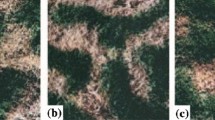Abstract
We analyse the model for vegetation growth in a semi-arid landscape proposed by von Hardenberg et al. (Phys. Rev. Lett. 87:198101, 2001), which consists of two parabolic partial differential equations that describe the evolution in space and time of the water content of the soil and the level of vegetation. This model is a generalisation of one proposed by Klausmeier but it contains additional terms that capture additional physical effects. By considering the limit in which the diffusion of water in the soil is much faster than the spread of vegetation, we reduce the system to an asymptotically simpler parabolic–elliptic system of equations that describes small amplitude instabilities of the uniform vegetated state. We carry out a thorough weakly nonlinear analysis to investigate bifurcations and pattern formation in the reduced model. We find that the pattern forming instabilities are subcritical except in a small region of parameter space. In the original model at large amplitude there are localised solutions, organised by homoclinic snaking curves. The resulting bifurcation structure is well known from other models for pattern forming systems. Taken together our results describe how the von Hardenberg model displays a sequence of (often hysteretic) transitions from a non-vegetated state, to localised patches of vegetation that exist with uniform low-level vegetation, to periodic patterns, to higher-level uniform vegetation as the precipitation parameter increases.















Similar content being viewed by others
References
Bel G, Hagberg A, Meron E (2012) Gradual regime shifts in spatially extended ecosystems. Theor Ecol 5:591–604
Burke J, Knobloch E (2006) Localized states in the generalized Swift-Hohenberg equation. Phys Rev E 73:056211
Burke J, Dawes JHP (2012) Localised states in an extended Swift–Hohenberg equation. SIAM J Appl Dyn Syst 11:261–284
Dagbovie AS, Sherratt JA (2014) Pattern selection and hysteresis in th Rietkerk model for banded vegetation in semi-arid environments. J R Soc Interface 11:20140465
Dawes JHP (2010) The emergence of a coherent structure for coherent structures: localized states in nonlinear systems. Phil Trans R Soc Lond A 368:3519–3534
Doedel EJ, Champneys AR, Fairgrieve T, Kuznetsov Y, Oldeman B, Paffenroth R, Sandstede B, Wang X, Zhang C (2011) AUTO-07p: continuation and bifurcation software for ordinary differential equations. http://indy.cs.concordia.ca/auto/
Gilad E, von Hardenberg J, Provenzale A, Shachak M, Meron E (2007) A mathematical model of plants as ecosystem engineers. J Theor Biol 244:680–691
Gowda K, Riecke H, Silber M (2014) Transitions between patterned states in vegetation models for semiarid ecosystems. Phys Rev E 89:022701
HilleRisLambers R, Rietkerk M, van den Bosch F, Prins HHT, de Kroon H (2001) Vegetation pattern formation in semi-arid grazing systems. Ecology 82:50–61
Kealy BJ, Wollkind DJ (2012) A nonlinear stability analysis of vegetative Turing pattern formation for an interaction-diffusion plant-surface water model system in an arid flat environment. Bull Math Biol 74:803–833
Klausmeier CA (1999) Regular and irregular patterns in semiarid vegetation. Science 284(5421):1826–1828
Lejeune O, Tlidi M, Couteron P (2002) Localized vegetation patches: a self-organised response to resource scarcity. Phys Rev E 66:010901(R)
Mabbutt JA, Fanning PC (1987) Vegetation banding in arid Western Australia. J Arid Environ 12:41–59
MacFadyan WA (1950a) Soil and vegetation in British Somaliland. Nature 165(4186):121
MacFadyan WA (1950b) Vegetation patterns in the semi-desert planes of British Somaliland. Geogr J 116:199–211
Meeuwig RO (1970) Infiltration and soil erosion as influences by vegetation and soil in northern Utah. J Range Manag 23:185–188
Meron E (2012) Pattern-formation approach to modelling spatially extended ecosystems. Ecol Model 234:70–82
Montana C, Lopez-Portillo J, Mauchamp A (1990) The response of two woody species to the conditions created by a shifting ecotone in an arid ecosystem. J Ecol 78:789–798
Rietkerk M, Boerlijst MC, van Langevelde F, HilleRisLambers R, van de Koppel J, Kumar L, Prins HHT, de Roos AM (2002) Self-organisation of vegetation in arid ecosystems. Am Nat 160:524–530
Sherratt JA (2005) An analysis of vegetation stripe formation in semi-arid landscapes. J Math Biol 51:183–197
Sherratt JA, Lord GJ (2007) Nonlinear dynamics and pattern bifurcations in a model for vegetation stripes in semi-arid environments. Theor Popul Biol 71:1–11
Sherratt JA (2010) Pattern solutions of the Klausmeier model for banded vegetation in semi-arid environments I. Nonlinearity 23:2657–2675
Siteur K, Siero E, Eppinga MB, Rademacher JDM, Doelman A, Rietkerk M (2014) Beyond Turing: the response of patterned ecosystems to environmental change. Ecol Complex 20:81–96
van der Stelt S, Doelman A, Hek G, Rademacher JDM (2012) Rise and fall of periodic patterns for a generalised Klausmeier-Gray-Scott model. J Nonlin Sci 10:1432–1467
von Hardenberg J, Meron E, Shachak M, Zarmi Y (2001) Diversity of vegetation patterns and desertification. Phys Rev Lett 87:198101
Zelnick YR, Kinast S, Yizhaq H, Bel G, Meron E (2013) Regime shifts in models of dryland vegetation. Phil Trans R Soc A 371:20120358
Zheng F-L (2006) Effect of vegetation changes on soil erosion on the Loess Plateau. Pedosphere 16:420–427
Acknowledgments
JHPD gratefully acknowledges the support of the Royal Society through a University Research Fellowship, and thanks Sarah Iams for useful discussions, and the anonymous referees for their useful comments.
Author information
Authors and Affiliations
Corresponding author
Rights and permissions
About this article
Cite this article
Dawes, J.H.P., Williams, J.L.M. Localised pattern formation in a model for dryland vegetation. J. Math. Biol. 73, 63–90 (2016). https://doi.org/10.1007/s00285-015-0937-5
Received:
Revised:
Published:
Issue Date:
DOI: https://doi.org/10.1007/s00285-015-0937-5




